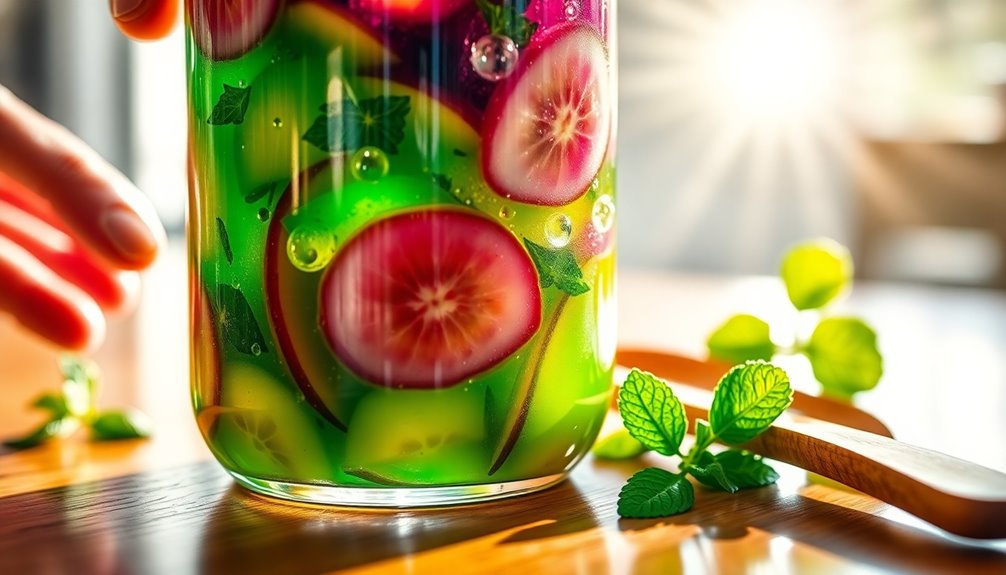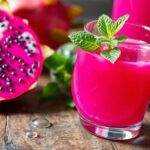To make bug juice, combine one 32-ounce bottle of purple grape juice and one 32-ounce bottle of raspberry apple juice in a large container. Chill the mixture in the fridge. Fill ice cube trays with the juice blend and toss in some blueberries, then freeze until solid. When ready to serve, pour the chilled juice into glasses with the frozen cubes and add lemon-lime soda for fizz. If you want tips on presentation and fun decorations, just keep going! For an extra touch of fun, consider garnishing each glass with a slice of fresh lemon or a sprig of mint. If you’re eager to explore other refreshing beverages, you can also learn how to prepare ash gourd juice, which adds a unique flavor profile to your summer drink repertoire. This vibrant bug juice is perfect for parties, and you can even create a themed drink station with colorful straws and playful cups!
Key Takeaways
- Combine equal parts grape juice and raspberry apple juice in a large container for a flavorful base.
- Fill ice cube trays with the juice mixture and add a blueberry to each compartment before freezing.
- Chill the juice mixture in the refrigerator to enhance its refreshing taste.
- Pour the chilled juice into glasses with frozen juice cubes, then add lemon-lime soda for fizz.
- Decorate the glasses with gummy worms to create a fun and whimsical presentation.

If you're looking to impress at your next summer gathering, making bug juice is a fun and refreshing choice. This colorful drink not only looks appealing but also tastes delicious, making it perfect for parties, picnics, or even casual get-togethers. You can easily whip it up using simple ingredients that are likely already in your pantry or fridge. Plus, it brings a sense of nostalgia, reminiscent of summer camp days where fun drinks brought everyone together.
To start, grab a large container and combine one 32-ounce bottle of purple grape juice with one 32-ounce bottle of raspberry apple juice. This mix creates a vibrant, eye-catching base for your bug juice. Once you have your juices combined, chill the mixture in the refrigerator. This step ensures your bug juice is cool and refreshing when it's time to serve. It's a good idea to prepare this in advance, allowing you to focus on other aspects of your gathering as it chills.
While the juice is cooling, you can take things up a notch by making some frozen juice cubes. Fill ice cube trays with the mixed juice, but here's the fun part: add a blueberry to each compartment before freezing them until solid. These fruit juice cubes not only keep your drink chilled but also add a burst of flavor as they melt. When you drop them into your glasses, they'll enhance the overall experience and make for a colorful display.
When it's time to serve your bug juice, you'll want to add a fizzy twist. Just before pouring the juices into glasses, add a 16-ounce bottle of lemon-lime soda to the chilled juice mixture. This step adds bubbles that make your drink even more refreshing and fun. The combination of the sweet fruit juice and the fizzy soda creates a delightful drink that everyone will enjoy.
Now, for the final touch—presentation. Pour the bug juice into glasses filled with the frozen juice cubes, and for that extra special flair, decorate the edges of each glass with gummy worms. This whimsical addition brings back childhood memories and makes the drink even more enticing for guests of all ages.
Picture this: a picnic table adorned with colorful glasses of bug juice, each one topped with playful gummy worms, instantly elevating the atmosphere of your gathering.
Not only is bug juice visually appealing, but it's also a drink that can be enjoyed by everyone, regardless of age. It's easy to make, fun to present, and sure to be a conversation starter at your summer event. So, gather your friends and family, and get ready to sip on this delightful concoction that's bound to be a hit!
Frequently Asked Questions
How Is Bug Juice Made?
To make bug juice, you start by dissolving flavored gelatin in hot water.
Then, mix in a variety of fruit juices like pineapple and orange for that refreshing taste.
If you want to sweeten it up, try adding some Manuka honey.
For a fizzy twist, pour in a carbonated drink like ginger ale.
You can even toss in gummy worms for fun!
Chill it with ice, and you're ready to enjoy a tasty treat!
How Unhealthy Is Bug Juice?
Bug juice can be a sweet siren's call, but it's not without its dangers. You might enjoy its sugary flavor, yet it's loaded with calories and can lead to weight gain.
With up to 25 grams of sugar per serving, it's easy to exceed daily limits, especially for kids. Plus, those artificial colors and flavors can stir up hyperactivity.
Frequent sipping could even invite dental issues, making it a treat to enjoy in moderation.
Is Bug Juice a Kool-Aid?
No, bug juice isn't exactly Kool-Aid.
While both are sweet, colorful drinks enjoyed especially at summer camps, bug juice is a more generalized term that refers to various mixed drinks made from fruit juices and sodas.
Kool-Aid is a specific brand of drink mix. You can think of bug juice as a creative blend of flavors, while Kool-Aid sticks to its recognizable taste and branding.
Both can be fun, customizable refreshments!
Why Was Bug Juice Discontinued?
You might think bug juice is a summer camp staple, but it's faded into nostalgia.
Concerns over high sugar content and artificial ingredients led to its discontinuation, as camps shifted to healthier options.
Bug juice became synonymous with unhealthy choices, sparking a demand for more natural beverages.
As society pushes for transparency in food and drink, bug juice couldn't keep up, leaving behind only memories of its sweet, colorful past.
Conclusion
Now that you've whipped up your own bug juice, you've unlocked a delightful concoction that's both refreshing and a little wild. Like a summer breeze through the trees, each sip dances on your tongue, blending flavors that spark joy. You've turned simple ingredients into a potion of fun, perfect for gatherings or quiet afternoons. So, let your creativity flow, and remember: every great recipe starts with a dash of adventure. Cheers to your newfound mixology skills!
Cindy thoroughly researches juicing trends, techniques, and recipes to provide readers with practical advice and inspiration. Her writing style is accessible, engaging, and designed to make complex concepts easy to understand. Cindy’s dedication to promoting the advantages of juicing shines through her work, empowering readers to make positive changes in their lives through the simple act of juicing.

















